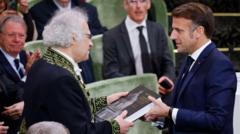In a ceremonial event at the Collège des Quatre-Nations, President Macron received the long-awaited ninth edition of the Dictionnaire de l’Académie Française, an effort that has consumed over four decades of work. This updated dictionary aims to encapsulate the evolution of the French language from the 1950s to the present day, showcasing some 21,000 new entries compared to its predecessor from 1935.
However, the pace at which language evolves raises questions about the dictionary’s relevance. Linguists have criticized the slow pace of updates, pointing out that while modern words like ‘tiktokeur’, ‘vlog’, ‘smartphone’, and ‘émoji’ are commonly used today, they remain absent from the Académie's reference. Instead, the dictionary includes less contemporary terms such as ‘soda’ and ‘sauna’, suggesting that it is already falling behind.
Moreover, while the new edition has incorporated some aspects of gender inclusion—providing female versions of traditionally male job titles—many previous entries still reflect outdated views. For instance, the definition of marriage as a union exclusively between a man and a woman stands in contrast to contemporary understandings of the term in French society.
The collective of linguists has expressed doubts about the utility of the dictionary amidst the rapid advancements of online dictionaries, which are known for their larger scope and quicker updates. Under the presidency of writer Amin Maalouf, the Academy continues to engage in regular discussions about new definitions. Still, criticisms linger about whether this dictionary can effectively serve as a definitive reference for a language undergoing continuous transformation.
While discussions for the next edition are already on the horizon, the needs of a modern, evolving language prompt many to wonder just how the Académie can reconcile its traditions with the realities of contemporary communication.




















